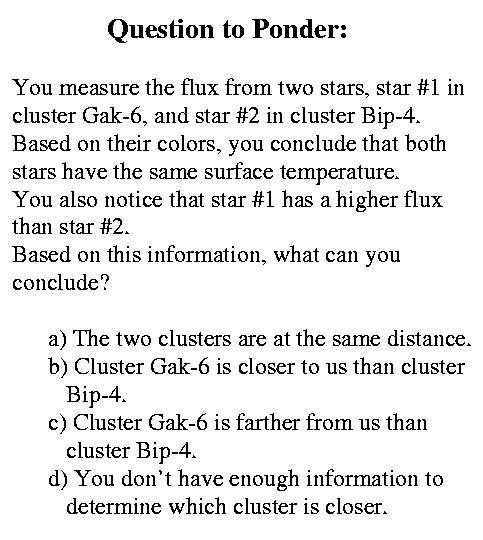|
We cannot control atomic energy to an extent which would be of any
value commercially, and I believe we are not likely ever to be able to
do so.Ernest Rutherford, Speech to the British Association for the Advancement of Science, 1933 |
Assignments:Read Chapter 26, Sections 1-6 (pp. 416-433)Problem Set #4 due Thursday 4 March 5pm
|

In Class:
---------------
not all star clusters look the same
H-R diagrams look different
lines represent where most of the stars are found
- some only have MS stars (Pleiades)
- some have MS stars, except only a few hot MS stars, plus a
few red giants
- some have only low mass MS stars, lots of RGs and and some WDs
Also differences in spatial distribution of stars
- tightly packed, spherical "globular" clusters
- less tightly packed, and more amorphous "open" clusters
This is actually a helpful distinction, cuz
- if you take all of the globular clusters
- they all look pretty much the same
- spherical, tightly packed
(though total numbers might differ)
- they all have pretty much the same H-R diagram
- very stubby MS
- no hot MS stars
- lots of RGs
- they also all appear to have pretty much the
same composition
- very "pure"
- mostly H, He
- very low abundances of "metals"
- C, N, O
--- all stars are almost completely H & He,
but these guys are extreme
Important point of distinction between globulars and open clusters
- open cluster stars generally have more metals
(still less than 1% of the mass)
- the Sun's composition is more typical of open cluster stars
than globular cluster stars
- referred to as Population I stars
- GC stars -->> Pop II
OK, so even though we don't know why GC's don't have a normal appearance
they all look pretty much the same, and we can treat them as a
separate group
-- they're only about 150 of these in our gax anyway
-- we'll come back to these oddballs later in class
there are a lot more open clusters
- gax is littered with them
- they do not have a regular appearance,
in spatial distribution
or on their H-R diagrams
However, they do appear to have similar compositions, so our
idea that the differences could be explained by compositions
doesn't look like it's gonna work.
The real answer to the mystery of the different HR diagrams comes from
how stars work
- how they generate energy
- and most importantly for the HR diagrams, how they age
Energy generation in stars
- we've already discussed how stars get hot
- squishing from gravity
- and a bit about how they stay hot
- nuclear fusion
Let's look at this process in a little more detail:
nuclear fusion
- often called nuclear "burning" but it's not burning at all
- burning is a chemical process
- atoms associate with one another
- mainly by "sharing" electrons
- the nuclei do not participate
- energy liberated comes from the sharing
of electrons
-- the energy of the compound
is lower than the energy of the
individual constituents
-- the atoms like each other and
want to be together
- nuclear fusion is a similar in a way, except that instead of
the atoms associating, it's the nuclei of the atoms
- atomic nuclei consist of aggregations of nucleons
- proton (positive charge)
- neutron (neutral charge)
- the number of protons in a nucleus determines
what kind of atom it is
- one proton --> H
- two protons --> He
- 26 protons --> Fe
- the number of neutrons in a nucleus determines
what isotope it is
- two protons, two neutrons
four nucleons --> everyday He: helium-4
- two protons, one neutron
three nucleons --> helium-3: rare
note: still Helium
cuz of two protons
- only certain combinations of protons and neutrons are
stable
- if you're too far out of balance, the
nucleus can't hold together
basically need something close to 1:1 balance
sometimes can have more neutrons
- nuclei can "decay"
- often a proton can turn into a neutron
- emit a positron
- usually results in the emission of energy
- getting to a more stable state
- sometimes very high energy photons
- "radioactive decay"
- dangerous for us
- this is the problem with nuclear waste
- when two nuclei combine, they create a different atom
entirely
- get two H atoms to stick together
- now you have a nucleus with two protons
--> He
- made He from 2 H
- write 1H1 + 1H1 --> 2He2
- takes a lot of energy
- H's both have positive charge
- repel strongly
- need to really smash them together
- need high speeds
--> high temperatures
- that's why the Sun is hot
- it doesn't generate energy until it gets
hot
- thus, it can't support itself against
collapse until the furnace turns on
- that's also why we don't have fusion
power plants
- need 10 million K
- hard to confine material at that
kind of temp
- bombs are easy
- if we could do it, we'd get lots of energy
- though they don't know it, H atoms
would prefer to be part of a larger nucleus
- if you can get them to stick, they're much
happier
- lower energy state than just by themselves
- generates lots of energy
- often called mass-energy conversion
- cuz 2He2 has less mass than 2 1H1's
- missing mass is converted into energy
via Einstein's E = mc^2
- this process doesn't actually work cuz 2He2
isn't stable
- it falls apart
- need some neutrons
- want to make 2He4 -- more stable
- the real process is a lot more complicated
- need to scare up some neutrons
|
![]()